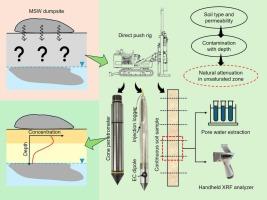A novel framework for measuring natural attenuation in the unsaturated zone below MSW dumpsites
IF 7.1
2区 环境科学与生态学
Q1 ENGINEERING, ENVIRONMENTAL
引用次数: 0
Abstract
Natural attenuation is a promising alternative to commonly employed active remediation strategies for municipal solid waste (MSW) dumpsites, such as capping, excavation, or pump-and-treat systems. While several studies and guidelines exist for monitoring natural attenuation of organics and inorganics in groundwater, limited research addresses its measurement in the unsaturated zone for inorganics. This study proposes a novel framework to evaluate natural attenuation for inorganic contaminants in the unsaturated zone, demonstrated through a case study of the Bhalswa dumpsite in Delhi, India. The framework integrates high-resolution site characterization using cone penetrometer, injection logger, and electrical conductivity (EC) probe, with the continuous soil sampling and pore water extraction for detailed contaminant profiling. The soil and pore-water samples were then analyzed for inorganic contaminants using standard analytical methods. The unsaturated zone of 2–4 m depth at Bhalswa dumpsite revealed significant attenuation of NH4+, Ni, Cr and As in regions where a 1–2 m natural clay layer was present. Attenuation reduced pore-water contaminant concentrations by 73 %–92 % and bulk soil EC by 40 %–50 %. In regions without clay, no attenuation was observed, as indicated by constant EC, total concentration in soil, and pore water concentration. Speciation modelling of the pore water was also conducted to get some insights into the attenuation mechanism for the contaminants. The proposed framework offers a structured, multi-step approach for assessing natural attenuation of inorganic contaminants in the unsaturated zone, particularly at MSW dumpsites.

一种测量城市生活垃圾倾倒场下非饱和带自然衰减的新框架。
自然衰减是一种很有前途的替代方案,通常用于城市固体废物(MSW)垃圾场的主动修复策略,如封顶,挖掘或泵和处理系统。虽然存在一些监测地下水中有机物和无机物自然衰减的研究和指南,但有限的研究涉及无机物在非饱和带的测量。本研究提出了一个新的框架来评估非饱和区无机污染物的自然衰减,并通过对印度德里巴尔斯瓦垃圾场的案例研究进行了论证。该框架集成了高分辨率的现场表征,包括锥形穿透仪、注入记录仪和电导率(EC)探头,以及连续的土壤采样和孔隙水提取,以获得详细的污染物剖面。然后使用标准分析方法对土壤和孔隙水样品进行无机污染物分析。Bhalswa垃圾场2 ~ 4 m深度的非饱和带显示,在1 ~ 2 m天然粘土层存在的区域,NH4+、Ni、Cr和As的衰减显著。衰减使孔隙水污染物浓度降低了73% - 92%,土壤EC降低了40% - 50%。在没有粘土的地区,没有观察到衰减,从恒定的EC、土壤总浓度和孔隙水浓度可以看出。此外,还对孔隙水进行了形态模拟,以了解污染物的衰减机制。拟议的框架提供了一个结构化的、多步骤的方法来评估非饱和区,特别是在城市生活垃圾倾倒场的无机污染物的自然衰减。
本文章由计算机程序翻译,如有差异,请以英文原文为准。
求助全文
约1分钟内获得全文
求助全文
来源期刊

Waste management
环境科学-工程:环境
CiteScore
15.60
自引率
6.20%
发文量
492
审稿时长
39 days
期刊介绍:
Waste Management is devoted to the presentation and discussion of information on solid wastes,it covers the entire lifecycle of solid. wastes.
Scope:
Addresses solid wastes in both industrialized and economically developing countries
Covers various types of solid wastes, including:
Municipal (e.g., residential, institutional, commercial, light industrial)
Agricultural
Special (e.g., C and D, healthcare, household hazardous wastes, sewage sludge)
 求助内容:
求助内容: 应助结果提醒方式:
应助结果提醒方式:


